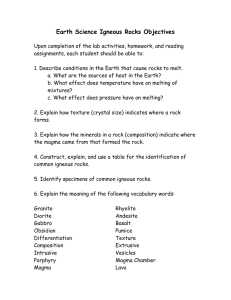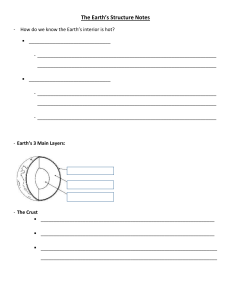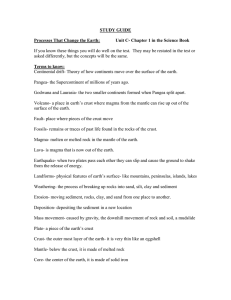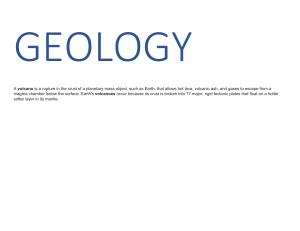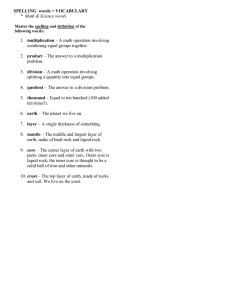Earth & Life Science Lesson Log: Endogenic Processes
advertisement
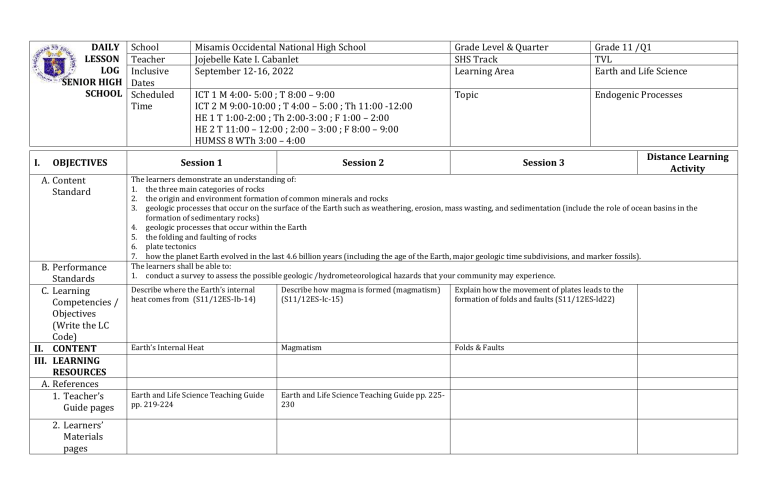
DAILY LESSON LOG SENIOR HIGH SCHOOL I. OBJECTIVES A. Content Standard B. Performance Standards C. Learning Competencies / Objectives (Write the LC Code) II. CONTENT III. LEARNING RESOURCES A. References 1. Teacher’s Guide pages 2. Learners’ Materials pages School Teacher Inclusive Dates Scheduled Time Misamis Occidental National High School Jojebelle Kate I. Cabanlet September 12-16, 2022 Grade Level & Quarter SHS Track Learning Area Grade 11 /Q1 TVL Earth and Life Science ICT 1 M 4:00- 5:00 ; T 8:00 – 9:00 ICT 2 M 9:00-10:00 ; T 4:00 – 5:00 ; Th 11:00 -12:00 HE 1 T 1:00-2:00 ; Th 2:00-3:00 ; F 1:00 – 2:00 HE 2 T 11:00 – 12:00 ; 2:00 – 3:00 ; F 8:00 – 9:00 HUMSS 8 WTh 3:00 – 4:00 Topic Endogenic Processes Session 1 Session 2 Session 3 Distance Learning Activity The learners demonstrate an understanding of: 1. the three main categories of rocks 2. the origin and environment formation of common minerals and rocks 3. geologic processes that occur on the surface of the Earth such as weathering, erosion, mass wasting, and sedimentation (include the role of ocean basins in the formation of sedimentary rocks) 4. geologic processes that occur within the Earth 5. the folding and faulting of rocks 6. plate tectonics 7. how the planet Earth evolved in the last 4.6 billion years (including the age of the Earth, major geologic time subdivisions, and marker fossils). The learners shall be able to: 1. conduct a survey to assess the possible geologic /hydrometeorological hazards that your community may experience. Describe where the Earth’s internal heat comes from (S11/12ES-Ib-14) Describe how magma is formed (magmatism) (S11/12ES-Ic-15) Explain how the movement of plates leads to the formation of folds and faults (S11/12ES-ld22) Earth’s Internal Heat Magmatism Folds & Faults Earth and Life Science Teaching Guide pp. 219-224 Earth and Life Science Teaching Guide pp. 225230 3. Textbook pages 4. Additional Materials from Learning Resources Portals Earth and Life Science Quarter 1 Module 3: Earth Materials and Processes DepEd Division of Cagayan de Oro B. Other Learning Resources IV. PROCEDURES A. Reviewing previous lesson or presenting the new lesson Earth and Life Science Quarter 1 Module 7 Department of Education – Region IV-A CALABARZON Earth and Life Science Quarter 1 – Module 10: Movement of Plates and Formation of Folds and Faults Department of Education – Region IV-A CALABARZON Earth and Life Science Quarter 1 - Module 5: Earth’s Geological Processes DepEd Division of Cagayan de Oro Olivar, J. T. et.al.,Exploring Life Through Science Series:Earth Science. Phooenix Publishing House, Inc. 2016 Review What are exogenic processes? What are examples of exogenic processes? Weathering Erosion Deposition Today, we will start endogenic processes. Decoding Time Your task is to reveal the magic words by decoding the given numbers to their corresponding letters of the alphabet. Then, complete the statement below using those words. discussing Endogenic processes are geologic processes that occur beneath the surface of the Earth (Valiao,2019). These processes are facilitated by forces that cause the Earth’s surface to move. These forces are called Endogenic forces. These endogenic forces are driven by heat. The Earth’s internal heat comes from two main sources: the radiogenic heat produced by the radioactive decay of isotopes in the mantle and crust, and the (7) _______________left over from the formation of the Earth. The heat can be transferred by three processes, namely, (8) Bend it or Break it! Materials: Ruler Four (4) different colors of clay or play dough Two (2) recycled/used cardboards Procedure: 1. Prepare the materials ahead as indicated above. 2. Roll out the different colors of play dough or clay into 6” by 6” flat layers that are 1/2-1” thick, depending on the materials used. 3. Stack the different-colored layers on top of each other on a flat surface (the different-colored layers represent rock layers). 4. Then place the layered block of clay between the two vertical cardboards and have them slowly squeeze the layered block of clay or play dough by pushing the two boards together from the sides. (In this step, you are modeling compression which occurs when Earth’s crust is squeezed together.) 5. STOP squeezing when you have pushed the layered clay or play dough about 1 inch on each side. 6. Record your observations on what the layered play dough or clay looks like now that you have squeezed it together. (Results will vary but each should either get a syncline [bend downwards] or anticline [bend upwards].) Poster Making Directions: On a 1/8 illustration board, make a poster that explains the formation of folds and faults due to plate tectonic movements of the Earth. A rubric is provided below to assess your output in this activity. ____________, (9) _______________. B. Establishing a purpose for the lesson C. Presenting examples/ instances of the new lesson Teacher says: Today, we are going to describe where the earth’s internal heat comes from. The competency is important because it allows us to trace the sources of heat of the Earth’s interior. At the end of the lesson, the students will be able to describe where the Earth’s internal heat comes from. Heat energy plays a vital role in our planet. It is one of the extreme factors in what makes the world livable. If you think of a volcano, you know Earth must be hot inside. The heat inside of our planet moves continents, build _______________, and (10) 7.Think of real-life formations that form due to compression forces. (For example, mountains and valleys could form due to compression forces.) 8. Flatten out your block of play dough or clay back to its original form. 9. Instead of squeezing the layered block of play dough or clay, pull on the sides with your hands. (In this step, you are modeling tension which occurs when the Earth’s crust is pulled apart.) 10. Think of real-life formations that occur as a result of tension forces. 11. Record what happened when you pulled the layered block apart. 12. Answer the following questions posted below. Share… 1) What happened when you squeezed the play dough or clay together? 2) What happened when you pulled the play dough or clay apart? Process… 1) What is the difference between compression and tension forces? 2) How do folds and faults form? 3) How did a model help explain the different forces that the Earth’s crust experiences? Teacher says: Today, we are going to describe how magma is formed. The competency is important because it enables us to describe the different conditions required in the formation of magma. At the end of the lesson, the students will be able to describe how magma is formed. Teacher says: Today, we are going to explain how the movement of plates leads to the formation of folds and fault. It is important to learn this lesson because it will help us understand how the different types of folds and faults are formed. At the end of our lesson, the students will be able to explain how the movement of plates leads to the formation of folds and fault using an illustration or drawing. Picture Analysis Picture Analysis mountains and causes earthquakes, but where does all this heat inside the earth come from? The teacher will ask the students to describe the picture. D. Discussing new concepts and practicing new skills #1 E. Discussing concepts and practicing new skills #2 Two categories of the internal heat sources of the Earth: 1. Primordial heat: heat from accretion and bombardment of the Earth during the early stages of formation. Earth was hot when it formed. A lot of Earth’s heat is leftover from when our planet formed, four-and-a-half billion years ago. Sources of primordial heat: a. Accretion energy b. Adiabatic compression 2. Radiogenic heat (the heat generated by long-term radioactive decay) Main sources are the four long-lived isotopes (large half-life) a. K40 potassium-40 b. Th232 thorium-232 c. U235 uranium-235 d. U238 uranium-238 It made a continuing heat source over geologic time. These are the four radioactive isotopes that are responsible for the majority of radiogenic heat. What is Magma? Magma is composed of semi-liquid hot molten rocks located beneath the Earth, specifically in the melted mantle rock and oceanic plate. This molten state, when solidified, creates igneous rocks found on the surface of the Earth. Magmatism is a process under the earth’s crust where formation and movement of magma occur. So where does these formation and movement take place? These happen in the lower part of the Earth’s crust and in the upper portion of the mantle, known as asthenosphere. How is magma formed? The magma present in the lower crust and upper mantle of the Earth is formed or generated through the process of partial melting. In this process, different minerals in rock melt at different temperature and pressure. Another factor being considered in this process is the addition of volatile materials such as water and carbon dioxide. Melting in the mantle requires one of three possible events to occur: Can you describe the pictures? What possibly happened to the rocks? What is Folding? The plate tectonic movement of the plates results in the deformation (folding and faulting) of the Earth’s crust. The different types of stress that act upon rocks play an important role in the movement of plates. Folding is the type of Earth movement resulting from the compression of rock because of high temperature and pressure from the interior of the Earth. Bending, curving, crumpling, or buckling of rocks into folds are usually visible on rock strata. Folding can also happen in oceans and seas. Types of folds 1. 2. 3. 4. 5. A monocline is a one-sided slope connecting two horizontal or gently inclined strata. An anticline depicts an upward fold on the rock. A syncline results from a downward fold on the rock. An overturned happens when one of its fold is pushed over the other limb due to the increasing pressure. A recumbent is an extreme type of overturned fold in which the axial plain acquires almost horizontal altitude. Radiogenic heat produces subatomic particles that zip away, and later collide with surrounding material inside the Earth. Their energy of motion is converted to heat. All such radioactive decay processes release heat as a by product of the ongoing reaction. Heat Transfer The heat from Earth’s interior is distributed through heat transfer. 1. 2. Heat transfer is the movement of thermal energy from a hotter place to a cooler place. Heat transfer can be classified into two such as: 1. Conduction heat transfer by direct contact of particles of matter. 2. Convection is a heat transfer when a fluid, such as air or a liquid, is heated and then travels away from the source. It carries the thermal energy along which creates a current. This happens because warmer particles tend to rise, while cooler particles tend to sink. F. Developing mastery Convection currents occur when warmer parts of a fluid rise, while cooler parts sink. Convection can also occur in some solids. For example, pressure and temperature conditions in the Earth's mantle allow mantle rock to slowly convert. Hotter rock rises and cooler rock sinks in mantle convection currents. This process is related to several other processes, including the movement of tectonic plates and the outward transfer of Earth's internal heat. Directions: Describe the following source of Earth’s internal heat by choosing the sentences in the table that 3. AN INCREASE IN TEMPERATURE: Conduction in mantle happens when heat is transferred from hotter molten rocks to the Earth’s cold crust. This process is known as heat transfer. As magma rises, it is often hot enough to melt the rock it touches. It happens at convergent boundaries, where tectonic plates are crashing together. A DECREASE OF PRESSURE: Mantle rocks remain solid when exposed to high pressure. However, during convection, these rocks tend to go upward (shallower level) and the pressure is reduced. This triggers the melting of magma. This is known as decompression melting. This process occurs at the Mid-Ocean Ridge, an underwater mountain system. ADDITION OF VOLATILES: When water or carbon dioxide is added to hot rocks, flux melting occurs. The melting points of minerals within the rocks decrease. If a rock is already close to its melting point, the effect of adding these volatiles can be enough to trigger partial melting. It occurs around subduction zones. Concept Map (Dyad Activity) Directions: Describe how magma is formed by completing the concept map. What is Faulting? Faulting is a geologic process forms cracks or fractures on the rocks. The movement is caused by low temperatures that make rocks brittle. Instead of folding, rocks break into large chunks. Different faults are named according to the type of stress that acts on the rock and by the nature of the movement of the rock that blocks at either side of the fault plane. Types of faulting 1. 2. 3. A normal (divergent) fault occurs when a rock is being pulled apart due to tension force. In this type of fault, the rock generally moves down. Reverse (convergent) fault happens when a rock is being squeezed due to compressional force. This type of fault generally moves up a rock. Transform (strike-slip) fault happens when rocks slide past each other in the opposite directions. The San Andreas fault is an example of this type of fault. Dyad Activity Directions: Each pair will get a paper from the box indicating what type of fold and fault is assigned to (Leads to Formative Assessment 3) best fit. Write your answer in the blank provided. them. Each pair will explain how the following folds and faults are formed. (10 pts) Release of thermal energy as a result of spontaneous nuclear disintegration. Internal heat accumulated by dissipation of planet. Release of accretional energy. Processes involved in mantle convection. Presence of different isotopes of heat producing element in the mantle and crust. Primordial Heat Radiogenic Heat G. Finding practical applications of concepts and skills in daily living What examples of heat transfer can we observed in our daily life activities? Apply It! Directions. Observe the illustrations below and relate these to the lesson. Directions. Supply the needed information by writing it on the space provided. “Everything happens for a reason.” How will I relate the given quotation to the lesson? How can we apply the concept of folds and faults in our daily life activities? In our life, we experienced different trials and circumstances. These trials and circumstances are like the folds and faults in our life. Sometimes we tend to bend and sometimes we tend to be displaced but whatever stresses or forces that may came to our life we remain strong. The teacher will ask the students to H. Making generalizations summarize the lesson. and abstractions about the lesson The teacher will ask the students to summarize the lesson. The teacher will ask the students to summarize the lesson. I. Evaluating learning Directions: Write a short essay describing where the Earth’s internal heat came from Content Organization Grammar/Spelling J. Additional activities for application or remediation V. REMARKS VI. REFLECTION A. No. of learners who earned 80% in the evaluation. B. No. of learners who require additional activities for remediation C. Did the remedial 10points 5 points 5 points 20points Which of which? Directions. Identify the sources of internal heat by writing RH for radiogenic heat and PH for primordial heat. Write your answer on a separate sheet of paper. ____1. Presence of different isotopes of heat producing element in the mantle and crust. ____2. Internal heat accumulated by dissipation of planet. ____3. Release of accretional energy. ____4. Processes involved in mantle convection. ____5. Release of thermal energy as a result of spontaneous nuclear disintegration. Directions: Complete the table by describing the different conditions required in the formation of magma. Conditions required for the formation of magma 1. Description decompression melting 2. Flux melting 3. Heat transfer What do you think? Directions. Based on the discussion, justify your answer to the following questions. a. Do you think partial melting will occur if the pressure is high in the asthenosphere? c. Do you think partial melting will occur if there is direct contact of hot molten rock in the Earth’s crust? b. Do you think partial melting will occur if there is too much amount of water in the subduction zone? Directions: Explain through an illustration/drawing the following folds and faults emphasizing its movement and direction. 1. Monocline fold 2. Anticline fold 3. Syncline fold 4. Normal fault 5. Reverse fault 6. Strike-slip faults How Folds and Faults are Formed? Explain how the movement of plates leads to the formation of folds and faults of the Earth. Write it in one (1) or two (2) paragraphs by browsing through the internet via YouTube using the link https://www.youtube.com/watch?v=wBeuUlh9ck E. A rubric will be used to rate your answer to this activity. lessons work? No. of learners who have caught up with the lesson. D. No. of learners who continue to require remediation. E. Which of my teaching strategies worked well? Why did it work? F. What difficulties did I encounter which my principal or supervisor can help me solve? G. What innovation or localized materials did I used/discover which I wish to share with other learners? Prepared by: Jojebelle Kate I. Cabanlet Teacher - II

